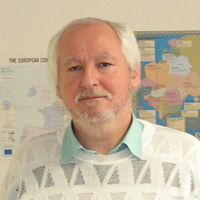Topic: Giant Magnetoresistance in Magnetic Nanostructures: A Unified View on Granular and Multilayer Systems
Speaker: I. Bakonyi
Wigner Research Centre for Physics, Hungarian Academy of Sciences. Budapest, Hungary
Time: 10:30-12:00, Tuesday, Sep.27, 2016
Venue: Room 468, Lee Hsun Building, IMR CAS
Welcome to attend!
Abstract:
In the last two decades, a lot of efforts have been devoted to studies of the giant magnetoresistance (GMR) effect in electrodeposited multilayer films which field has been reviewed recently [1]. We have presented experimental results which enabled us to reveal that the commonly observed strongly non-saturating behaviour of the field-dependence of the GMR in these systems originates from the presence of superparamagnetic (SPM) regions in the magnetic layers. More recently, we have identified a physical model elaborated originally for granular metals [2,3] and could be well adapted for the case of electrodeposited multilayers [4]. A new procedure has also been presented how to separate the SPM contribution to the GMR from the conventional ferromagnetic GMR contribution [4]. This represents a significant progress in understanding the underlying physical processes.
In the present contribution, we intend to give a description of the spin-dependent scattering processes occurring in various magnetic nanostructures which form the basis for explaining the phenomenon of GMR. The two limiting cases are (i) classical granular metals in which nanoscale non-interacting ferromagnetic (FM) particles with SPM characteristics are embedded in a non-magnetic matrix and (ii) perfect nanoscale metallic multilayers in which FM layers are separated by non-magnetic layers. In the first case, the field dependence of the magnetoresistance is proportional [3] to the square of the Langevin function L(x) describing the field dependence of the magnetization where x = H/kT with as the average SPM particle moment. In perfect multilayers, the field dependence of the GMR is governed by the interplay between the coupling between the FM layers via the non-magnetic spacer layers and the magnetic anisotropy.
Due to a distribution of SPM particle size in granular metals, there may be larger particles which exhibit FM behaviour, i.e., their magnetization orientation does not fluctuate as was for the SPM state. In such cases, the GMR field dependence was found [2] to be proportional to L(x) and not to the square of L(x) and this new feature could be explained [3] by taking into account spin-dependent electron transport processes for electrons travelling between a FM and a SPM particle. At the other end, in magnetic/non magnetic multilayers, SPM regions can often occur and then applying the same model, we can observe a GMR term with a field dependence proportional to L(x) [4].
Besides the general overview of spin-dependent transport processes in ideal and non-ideal magnetic nanostructures, we also present our recent theoretical results [5] for the field dependence of the GMR in the case of antiferromagnetic and/or orthogonal coupling in the absence of any magnetic anisotropy. The talk will also give a brief description of the preparation of multilayers by electrodeposition and present our main results on their GMR behaviour [4,6,7]. More details about electrodeposited multilayers can be found in our review [1].
References:
[1] I. Bakonyi, L. Péter: Electrodeposited multilayer films with giant magnetoresistance (GMR): progress and problems. Progr. Mater. Sci. 55, 107-245 (2010)
[2] B.J. Hickey, M.A. Howson, S.O. Musa and N. Wiser, Phys. Rev. B 51, 667 (1995)
[3] N. Wiser, J. Magn. Magn. Mater. 159, 119 (1996)
[4] I. Bakonyi, L. Péter, Z. Rolik, K. Kiss-Szabó, Z. Kupay, J. Tóth, L. F. Kiss and J. Pádár, Phys. Rev. B 70, 054427 (2004)
[5] K. Szász and I. Bakonyi, J. Spintr. Magn. Nanomater. 1, 157 (2012)
[6] L. Péter, Z. Rolik Z, L.F. Kiss, J. Tóth, V. Weihnacht, C.M. Schneider, I. Bakonyi, Phys. Rev. B 73, 174401 (2006)
[7] I. Bakonyi, E. Simon, B.G. Tóth, L. Péter and L.F. Kiss, Phys. Rev. B 79, 174421 (2009)
Biography:
 Dr. Imre Bakonyi received his C.Sc. and D.Sc. from the Hungarian Academy of Sciences (HAS) and his Ph.D. from the Eötvös University in Budapest, Hungary. He has served as the Head of Metals Research Department at HAS and is currently a scientific advisor with the Academy. Dr. Bakonyi has received the Research Awards of Physics Research Centre of HAS, Zoltan Gyulai Award, and the Annual Publication Awards of ISSPO. Dr. Bakonyi has a total of nearly 200 research papers in English, 1 patent, 2 book chapters, and about 2,600 citations to published papers; his research expertise is in the preparation, thermal stability, atomic and electronic structure, electrical transport and magnetic properties of amorphous, nanocrystalline, multilayered and other metastable metallic phases, metal hydrides. His current focus of research is the giant magnetoresistance (GMR) in electrodeposited multilayers and multilayered nanowires.
Dr. Imre Bakonyi received his C.Sc. and D.Sc. from the Hungarian Academy of Sciences (HAS) and his Ph.D. from the Eötvös University in Budapest, Hungary. He has served as the Head of Metals Research Department at HAS and is currently a scientific advisor with the Academy. Dr. Bakonyi has received the Research Awards of Physics Research Centre of HAS, Zoltan Gyulai Award, and the Annual Publication Awards of ISSPO. Dr. Bakonyi has a total of nearly 200 research papers in English, 1 patent, 2 book chapters, and about 2,600 citations to published papers; his research expertise is in the preparation, thermal stability, atomic and electronic structure, electrical transport and magnetic properties of amorphous, nanocrystalline, multilayered and other metastable metallic phases, metal hydrides. His current focus of research is the giant magnetoresistance (GMR) in electrodeposited multilayers and multilayered nanowires.



